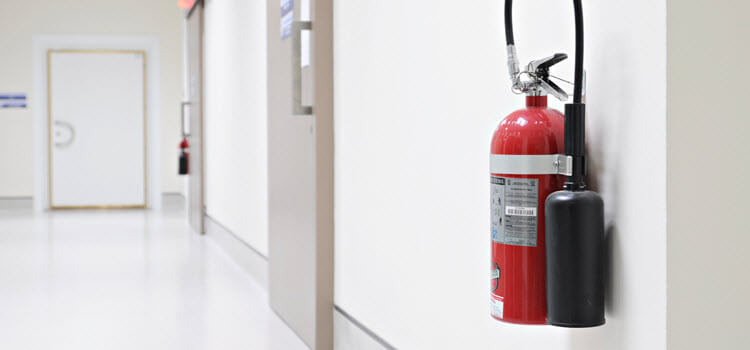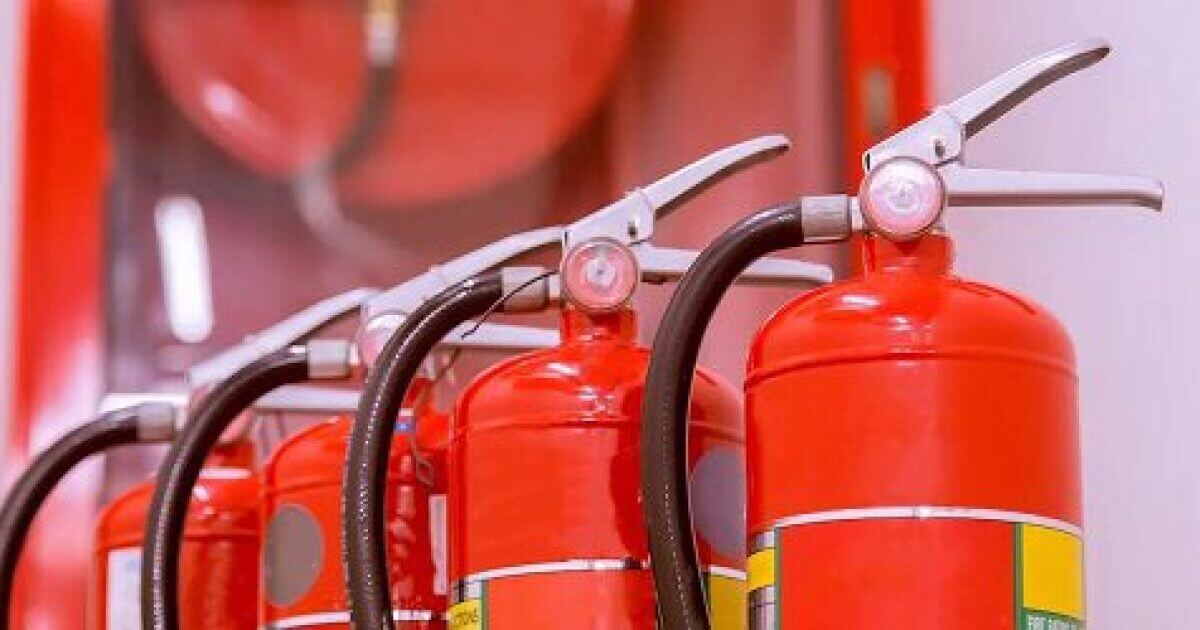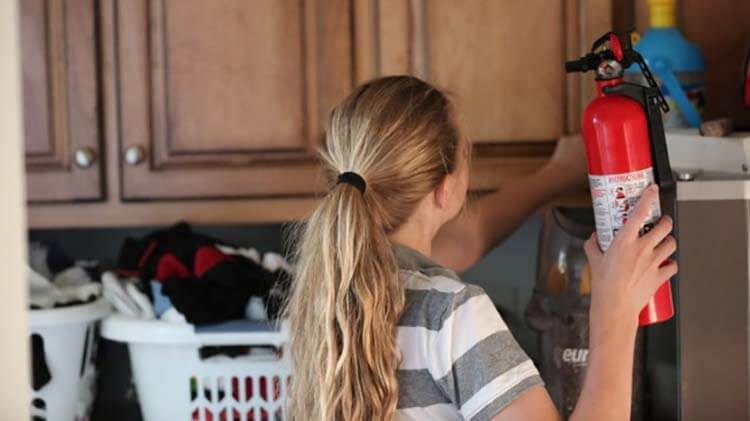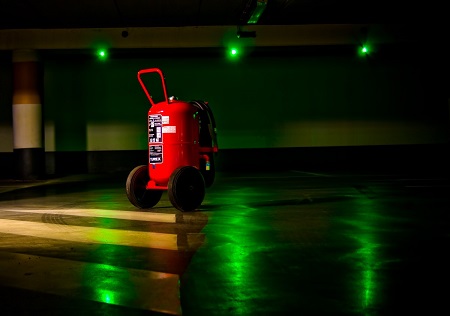The Top 12 Places to Keep Your Fire Extinguisher
February 24, 2023
A fire extinguisher is an essential piece of equipment in your home, and you might ask, “Where should I keep my fire extinguisher?”. We will discuss the top 12 places to keep them. Keeping your fire extinguishers in a place where you can easily access them in a fire emergency is critical to your safety and your home’s security!
So, where are the ideal places to keep your fire extinguisher? Here are the 12 most common places to store one:
12 Best Places to Keep Your Fire Extinguisher
1. Near the kitchen
This room in your home typically has many potential fire hazards. The kitchen is also a room where people spend a lot of time, so having an extinguisher close by can help prevent fires from spreading and causing more damage.
A good rule of thumb is to keep it about 30 feet from the stove. This way, you’ll have easy access to it. You can mount the extinguisher by the kitchen door or in an adjoining room if you have a small kitchen.

2. In the garage
Many garages contain flammable materials such as gas cans and chemicals. In addition, it has electrical fires common in garages due to all the power tools and electronic equipment typically stored there.
Finally, garages are often the entryway into your home, so having a fire extinguisher close by in case of an emergency is always a good idea.

4. Near the front door
As you can see, there are many places where you can keep a fire extinguisher. However, the front door is one of the best places to keep it.
It’s an easily accessible spot, and it is also visible. Additionally, keeping your fire extinguisher near the front door will remind you to check it regularly to ensure it is in working order. Doing this can provide you and your family safe from house fires.

5. Near the back door
In case of kitchen fires, you’ll want to be able to make a quick exit. Keeping an extinguisher near the back door will allow you easy access to grab it and make your escape immediately.

6. In your car
The car is a great place to keep your fire extinguisher because it’s usually the first place you’ll go in an emergency. It’s also a good idea to keep one in your trunk in case of a fire.
If you have a fire extinguisher in your car, make sure it’s easily accessible and close to the exits. You should also check the expiration date and ensure it’s in good working order.

7. Near the pool or hot tub
The hot tub collection is a great place to keep fire extinguishers because it’s usually close to the house and easy to access in an emergency. Plus, if you have a fire in the pool or hot tub, you can use the extinguisher to put it out quickly.
Ensure you don’t use too much water from the extinguisher, as it could damage the pool or hot tub.
8. In your office
Another great place to keep an extinguisher is in your office or workspace.
This is especially important if you have any electrical equipment in your office, as fires can start easily and spread quickly in these environments. In addition, an extinguisher can help you control a fire before it gets out of hand.

9. In the attic
The attic is one of the top places to keep fire extinguishers because it is out of the way and usually not accessed frequently.
It is usually cooler than the rest of the house, which will help prolong its shelf life. So, if you are looking for an excellent place to store your fire extinguisher, the attic is a great option.
10. In a storage area or closet
Closets and storage areas are great places to keep your fire extinguisher because they are also usually cooler than the rest of the house, which will help prolong your fire extinguisher’s shelf life.
Like the attic, you don’t usually stay here but keeping a fire extinguisher in your closet or storage area is still an excellent great option.

11. In the laundry room
Laundry rooms are a great place to keep your fire extinguishers because it’s usually close to the kitchen.
Another reason the laundry room is an excellent place for your fire extinguisher is because it’s usually close to an exit. So if a fire does start in the laundry room, you’ll be able to get out quickly and safely.

12. In the basement
The basement is one of the most common places to keep a fire extinguisher for two reasons.
First, it is out of the way and not in plain sight like in the kitchen. Second, it is usually close to the laundry room, where there is a higher risk for fires.

Tips in Choosing the Right Place to Keep Your Fire Extinguisher at Home
There are different factors to consider when choosing the right place for your fire extinguisher. Here are some fire safety tips:
- Fire extinguishers should be easily accessible. It should be placed in an area where it can be reached quickly in case of a fire.
- Fire extinguishers should be visible. It should be placed in a location where it can be easily seen.
- Fire extinguishers should be close to the exit. It should be placed in a location where it will not block the door in case of a fire.
- Fire extinguishers should be away from heat sources. It should not be placed near cooking equipment such as stoves, ovens, or other heat sources.
- Fire extinguishers should be away from flammable materials. It should not be placed near combustible materials such as paper, gasoline, or chemicals.
Following these tips from fire experts will help ensure that your fire extinguisher is practical and ready to use in case of a fire.
Reminders in Using Fire Extinguishers
The National Fire Protection Association offers training courses that can teach you how to use a fire extinguisher properly at a safe distance.
The next step is identifying the fire type and its leading cause. Class A fires are fueled by paper or wood and are the most common. Class B fires are flammable liquids, grease, and gasoline. Class C and D fires involve combustible metals.
Once the type of fire is identified, you can determine which fire extinguisher to use. Class A fires should be extinguished with water, and Class B fires with foam, Class C with CO₂, and Class D with dry powder.
It is important to remember that each type of extinguisher is specific to certain types of fires, so be sure to use the correct one for your safety!
It is also essential to regularly check your fire extinguisher to ensure that it is in working order. It will help if you familiarize yourself with how to use a fire extinguisher so that you are prepared in case of a fire.
Remembering a fire extinguisher is not a “catch-all” solution for every fire situation. In addition, there are limitations to what each type of extinguisher can do, so be sure you are using the right one to extinguish the fires.
Also, please read the instructions on the extinguisher before using it, as improper use can cause more harm than good.
Finally, fire extinguishers are only a temporary solution. The best way to prevent a fire from starting in the first place is to practice safe habits and have a plan in place in case of an emergency.
With some preparation, you can help keep your home safe and protect it from fire.
Where should you not keep your fire extinguisher?
There are a few places where you definitely should not keep your fire extinguisher due to being dangerous and a potential fire source.
- One is near the stove, fireplace, or any other location with open flames because it can cause grease fires.
- Other areas where it would be exposed to excessive heat, like next to the furnace, fireplaces, and chimneys.
- And finally, you shouldn’t keep it in a location where it would be difficult to reach in times of an emergency.
Following these simple guidelines can prevent any house fires and keep you away from any leading cause.
How many fire extinguishers are needed at home?
The National Fire Protection Association (NFPA) recommends that every home have at least one working fire extinguisher.
However, depending on the size of your home and the layout, you may need more than one fire extinguisher.
The best way to determine the numbers you need is to create a home fire escape plan.
Once you have created your plan, you can determine how many fire extinguishers you need and where they should be placed.
Please contact your local fire department if you have any questions about creating a home fire escape plan or need help determining how many extinguishers you need.
Safety Storage for Fire Extinguishers
There are many ways to store fire extinguishers. The best way to store a fire extinguisher is in a cool, dry place where it will not be exposed to extreme temperatures to prevent an explosion.
Most fire extinguishers are pressurized, so if you find rust or corrosion on your extinguisher, it’s best to replace it. However, don’t take the chance of having a fire and not having a working fire extinguisher!
While most modern fire extinguishers don’t need to be stored upright, if it says “UPRIGHT” or “VERTICAL,” you need to keep it upright. First, check the pressure gauge on your extinguisher. If the needle is in the green zone, the extinguisher is pressurized, and you don’t need to worry about storing it upright. If the hand is in the red area, the extinguishers must be recharged.
It should also be stored away from flammable liquids and materials and out of the reach of children.
By following these fire safety tips, you can ensure that your extinguishers are stored correctly and are ready to use in the event of a fire.
